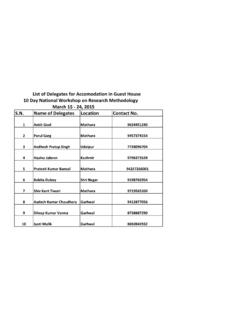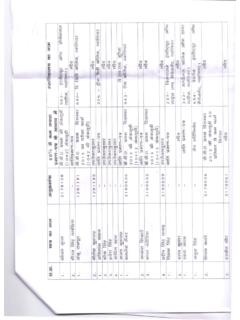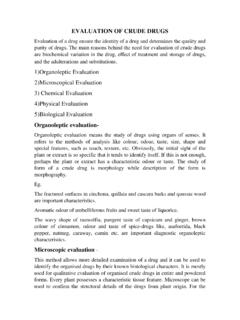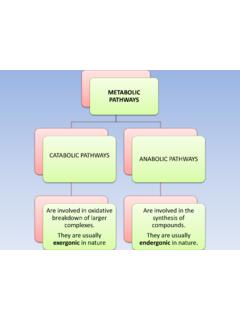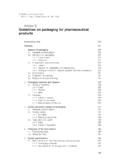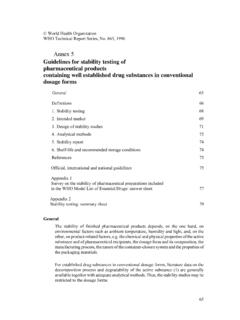Transcription of PACKAGING PHARMACEUTICAL PACKAGING - Jiwaji University
1 PHARMACEUTICAL PACKAGINGPHARMACEUTICAL PACKAGING Presented By Rajendra Chauhan Asst. Professor in PHARMACEUTICAL Sciences INTRODUCTION PACKAGING is the science, art and technology of enclosing or protecting products for distribution, storage, sale, and use. PACKAGING also refers to the process of design, evaluation, and production of packages. PHARMACEUTICAL PACKAGING can be defined as the economical means of providing presentation, protection, identification , information, convenience ,compliance , integrity and stability of the product .FUNCTIONS OF PACKAGING Product Identification:- PACKAGING greatly helps in identification of products. Product Protection:- PACKAGING protects the contents of a product from spoilage, breakage, leakage, etc.
2 Facilitating the use of product:- PACKAGING should be convenience to open, handle and use for the consumers. Product Promotion:- PACKAGING is also used for promotional and attracting the attention of the people while OF PACKAGING Primary PACKAGING - is the material that first envelops the product and hold it. This usually is the smallest unit of distribution or use. Ex. Aerosol spray can, blister packs, bottleSecondary PACKAGING -Is outside the primary PACKAGING perhaps used to group primary package together. Ex. Boxes, cartonsTertiary PACKAGING - is used to bulk handling and shipping. Ex. Barrel, container, edge protectorPACKAGE TESTING Drop test Vibration test Shock test Inclined impact test Revolving drum testTYPES OF PACKAGING MATERIALS USED FOR PHARMACEUTICAL PACKAGING Glass Plastics Rubbers Paper/card boards MetalsTHE CHOICE OF PACKAGING MATERIAL WILL DEPEND UPON: The degree of protection required Compatibility with the dosage form Customer convenience size, weight of dosage form , Filling method Sterilization method to be employed and costGLASS:Glass has been widely used as a drug PACKAGING material Advantages They are transparent.
3 They have good protection power. They can be easily labelled. Economical Variety of sizes and shapes Disadvantages Glass is fragile so easily broken. Release alkali to aqueous preparationCOMPOSITION OF GLASS Sand (silicon dioxide) Soda ash (sodium carbonate) Limestone (calcium carbonate) Cullet (broken glass) - aluminium, boron, potassium, magnesium, zinc, barium, Amber: light yellowish to deep reddish brown, carbon and sulphur or iron and manganese dioxide Yellow: Compounds of cadmium and sulphur Blue: Various shades of blue, cobalt oxide or occasionally copper (cupric) oxide Green: iron oxide, manganese dioxide and chromium dioxideMANUFACTURE OF GLASS: The four basic processes used in the production of glass are: Blowing uses compressed air form the molten glass in the cavity of metal mold. In drawing , molten glass is pulled through dies or rollers that shape the soft glass.
4 In pressing mechanical force is used to press the molten glass against the side of a mold. Casting uses gravity or centrifugal force to cause molten glass to form in the cavity of OF GLASS Type I Highly resistant borosilicate glass Type II Treated soda lime glass Type III soda lime glass NP soda glass (non parenteral usage)Type I-borosilicate glass Alkalinity is removed by using boric oxide to neutralized the oxide of potassium and sodium It is highly resistant glass. It has high melting point so can with stand high temperatures. It is more chemically inert than the soda lime glass It can resist strong acids,alkalies and all types of solvents. Reduced leaching action. USES: Laboratory glass injection and water for II-treated soda lime glass Type II containers are made of commercial soda lime glass that has been dealkalized or treated to remove surface alkali.
5 The de-alkalizing process is know as sulphur treatment. Sulfur treatment neutralizes the alkaline oxides on the surface, rendering the glass more chemically resistant. Uses: Used for alkali sensitive products. Infusion fluids, blood and plasma. Large volume Plastics may be defined as any group of substances, of natural or synthetic origins, consisting chiefly of polymers of high molecular weight that can be moulded into a shape or form by heat and Less weight than glass, flexible Variety of sizes and shapes Essentially chemically inert, strong, rigid Safety use, high quality, various designs Extremely resistant to breakage Disadvantages Absorption permeable to moisture Poor printing, thermostatic charge TYPES OF PLASTICS Thermosetting type When heated they may become flexible but they do not become Urea formaldehyde (UF),Phenol formaldehyde ,Melamine formaldehyde (MF), Epoxy resins (epoxides), Polyurethanes (PURs) Thermoplastics type- On heating they are soften to viscous fluid which harden again on cooling.
6 Polyethylene{HDPE LDPE}, Polyvinylchloride(PVC),Polystyrene Polypropylene, Nylon(PA), Polyethylene terepthalate(PET) ,Polyvinylidene chloride(PVdC), Polycarbonate Acrylonitrile butadiene styrene(ABS)METALS : Metals are used for construction of containers. The metals commonly used for this purpose are aluminium ,tin plated steel, stainless steel, tin and leadAdvantages: They are impermeable to light, moisture and gases. They are made into rigid unbreakable containers by impact extrusion. They are light in weight compared to glass containers. Labels can printed directly on to their : They are expensive. They react with certain chemicalsCOLLAPSIBLE TUBES METAL The collapsible metal tube is an attractive container that permits controlled amounts to be dispensed easily, with good reclosure, and adequate protection of the product.
7 It is light in weight and unbreakable and lends itself to high speed automatic filling operations. Most commonly used are tin, aluminium and : Tin containers are preferred for food, pharmaceuticals and any product for which purity is considered. Tin is the most chemically inert of all collapsible metal tubes .Aluminium: Aluminium tubes offer significant savings in product shipping costs because of their light weight . They are attractive in natureLead: Lead has the lowest cost of all tube metals and is widely used for non food products such as adhesives, inks. paints and lubricants. Lead should never be used alone for anything taken internally because of the risk lead poison . With internal linings, lead tubes are used for products such as chloride tooth : Rubber is used mainly for the construction of closure meant for vials, transfusion fluid bottles, dropping bottles and as washers in many other types of product.
8 BUTYL RUBBER: Advantages: Permeability to water vapour . Water absorption is very low. They are relatively cheaper compared to other synthetic rubbers. Disadvantages: Slow decomposition takes place above 130 C. Oil and solvent resistance is not very RUBBER: Advantages : Oil resistant due to polar nitrile group. Heat resistant. Disadvantages: Absorption of bactericide and leaching of extractives are considerable. CHLOROPRENE RUBBERS : Advantages: Oil resistant. heat stability is RUBBERS: Advantages: Heat resistance. Extremely low absorption and permeability of water. Excellent aging characteristic. Disadvantages: They are very expensive. TAMPER RESISTANT PACKAGING : The requirement for tamper resistant PACKAGING is now one of the major considerations in the development of PACKAGING for PHARMACEUTICAL products. Tamper resistant package is one having an indicator to entry in which, if missing, can reasonably be expected to provide visible evidence to consumers that tampering has occurred.
9 FDA approves the following configurations as tamper resistant PACKAGING : Film wrappers, Blister package, Strip package, Bubble pack, Shrink seals, and bands Oil, paper, plastic pouches, Bottle seals, Tape seals, Breakable caps, Aerosol containers Film wrapper Film wrapping has been used extensively over the years for products requiring package integrity or environmental protection. It is categorizes into following types: End folded wrapper Fin seal wrapper Shrink wrapperEnd folded wrapper The end folded wrapper is formed by passing the product into a sheet of over wrapping film, which forms the film around the product and folds the edges in a gift wrap fashion. The folded areas are sealed by pressing against a heated bar. The materials commonly used for this purpose are cellophane and polypropylene. Fin seal wrapper The seals are formed by crimping the film together and sealing together the two inside surfaces of the film, producing a fin seal.
10 Fin sealing is superior than end folded wrapper With good seal integrity the over wrap can removed or opened by tearing the wrapper Shrink wrapper The shrink wrap concept involves the PACKAGING of the product in a thermoplastic film that has been stretched and oriented during its manufacture. An L shaped sealer seals the over wrap The major advantage of this type of wrapper are the flexibility and low cost of PACKAGING equipment .BLISTER PACKAGE: Blister package provides excellent environmental protection, and efficacious appearance. It also provides user functionality in terms of convenience , child resistance and tamper resistance The blister package is formed by heat softening a sheet of thermoplastic resin and vacuum drawing the soften sheet of plastic into a contoured mold . After cooling the sheet is released from the mold and proceeds to the filling station of the machine.


